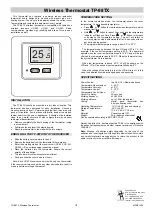
DE
GB
FR
69
4.2 Montage des DCF-Empfängers
Gefahr der Durchfeuchtung von
Wand und Gerät!
Durch eine entsprechende Kabel-
führung und sorgfältige Arbeits-
weise ist die Wasserdichtheit des
DCF-Empfängers sowie des
Gebäudes sicher zu stellen.
Das Gerät muss in der Einbaulage, wie
nebenstehend gezeigt, an der Wand
befestigt werden! Die Kabeleinführung (
3
)
muss nach unten zeigen.
• Anschlußkabel (
4
) mit leichter
Neigung nach Außen bauseits
verlegen.
• Gehäuse (
2
) öffnen und mit 2 Schrauben
(
5
) an der Wand befestigen.
• Anschlußkabel von unten durch die
Kabeleinführung (
3
) schieben. Die
Verschraubung muss nicht gelöst
werden.
Die Dichtung in der Verschraubung
passt sich dem Durchmesser des
verwendeten Kabels an (Kabeldurch-
messer: 4,5 bis 10 mm).
• Beim Anbringen des Gehäuseober-
teiles (
1
) die Dichtung nicht vergessen
und das Gehäuseoberteil aufdrücken
bis es einrastet.
4.2 Fitting of the DCF Receiver
(not currently available in GB)
There is a danger of moisture pene-
trating the wall and the appliance!
The water-tightness of the DCF
receiver and of the building must be
ensured by an appropriate cable
pipe and by a careful working
method.
The appliance must be secured to the
wall in the fitting position as shown
opposite! The cable entry (
3
) must be
pointing down.
• Lay the connecting cable (
4
) at a slight
incline to the outside away from the
building.
• Open the housing (
2
) and secure to
the wall with 2 screws (
5
).
• Push the connecting cable from below
through the cable entry (
3
). The screw
connection must not become loose.
The sealing ring in the screw
connection fits the diameter of the
cable used (cable diameter: 4.5 to
10 mm).
• When fitting the upper part of the
housing (
1
), do not forget the sealing
ring and press the upper part of the
housing until it locks.
4.2 Montage des DCF-Empfängers
Risque de pénétration d’humidité
dans le mur et l’appareil!
Pour garantir l’étanchéité du
récepteur DCF et du bâtiment,
faites passer les câbles de manière
adéquate et travaillez avec soin.
L'appareil doit être fixé sur le mur dans la
position indiquée dans la figure ci-contre!
L'entrée de câble (
3
) doit être dirigée vers
le bas.
• Posez le câble de raccordement (
4
)
légèrement incliné vers
l’extérieur.
• Ouvrez le boîtier (
2
) et fixez-le au mur
à l’aide de 2 vis (
5
).
• Passez le câble de raccordement dans
l’entrée de câble (
3
) par le bas. Ne
desserrez pas le raccord à vis. Le joint
du raccord à vis s’adapte au diamètre
du câble utilisé (diamètre du câble:
4,5 à 10 mm).
• Lors du montage de la partie
supérieure du boîtier (
1
), n’oubliez
pas le joint et appuyez sur la partie
supérieure du boîtier jusqu’à ce
qu’elle s’enclenche.
Summary of Contents for VRC 420
Page 52: ...52 ...
Page 56: ...56 1 2 3 3 7 8 9 4 VRC_VC_054 0 VRC_VC2_021 0 ...
Page 60: ...60 bar 2 1 3 0 Party Sa 15 C C VRC VCC 1 0 2 3 1 2 3 3 4 3 VRC VC2_022 0 ...
Page 68: ...68 4 4 3 3 1 2 5 DCF 0 AF VRC_DCF_003 ca 40 mm 4 5 10 mm DCF 0 AF VRC_DCF_004 ...
Page 76: ...76 ϑ ϑ 3 3 3 2 3 3 4 2 230V 3 3 2 3 3 VRC VC2_002 2 ...
Page 78: ...78 230V 3 2 3 3 3 4 3 3 3 2 3 3 3 VRC 420 VRC 420 VRC VC2_005 1 ...
Page 82: ...82 Party Sa 15 C C VRC VCC 1 0 2 3 1 2 3 1 2 2 1 7 6 5 3 4 VRC 420 VRC VC2_020 0 ...
















































